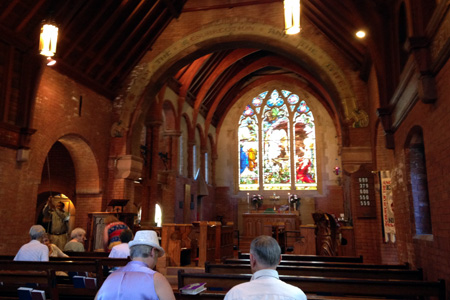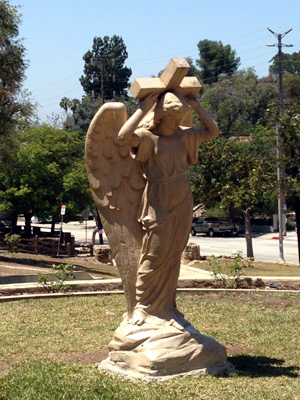| |
 |
 |
 |
| Comment on this report, or find other reports. |
 |
| Our Mystery Worshippers are volunteers who warm church pews for us around the world. If you'd like to become a Mystery Worshipper, start here. |
 |
| Find out how to reproduce this report in your church magazine or website. |
|
|
| 2880: Church of the Angels, Pasadena, California, USA |
 |
 |
 |
Mystery Worshipper: Red Tory.
The church: Church of the Angels, Pasadena, California, USA.
Denomination: The Episcopal Church, Diocese of Los Angeles.
The building: Dating from 1889, the church is Pasadena's oldest and was built as a memorial to Alexander Campbell-Johnston, a wealthy landowner, by his widow Frances. It is a very attractive small Gothic revival style church in a standard cruciform shape. There is a stairway for pedestrians going up the hill from the street, as well as a drive for cars that slopes up to the church front. In front of the building is a large statue of an angel carrying a cross on her back.
The building was modeled after St Mary the Virgin near Dorking, Surrey, England, but is not an exact copy. The influence of the Arts and Crafts movement is evident throughout the building and its furniture. The interior is red brick and redwood, with fir pews on both sides of a single center aisle. There is a striking mosaic of St Gabriel the Archangel on the back wall of the church. A huge stained glass window above the altar shows the empty tomb on Easter morning. There is a very lovely alabaster and marble font in a small bay baptistery at the back of the church. The Sylmar earthquake of 1971 damaged the tower, and it was taken down and not reassembled until 20 years later. There is a small room in the tower with a window looking down on the pew that belonged to Frances Campbell-Johnston, the church's benefactress, so that the priest could see whether she had arrived before starting the service.
The church: Also known as the Bishop's Chapel, the church is a very popular wedding venue and often makes an appearance in movies and TV shows. It seems that they take their membership in the wider Episcopal and Anglican communities very seriously. The announcements included reminders of activities such as reviews of books and movies as well as a lengthy discussion of both the shootings that had occurred in Charleston in the previous week and of the congregationís upcoming disaster preparedness event, which was apparently planned before those shootings happened. The rector spoke about the testimony of the congregation of the AME church in Charleston and the extraordinary example they provide of the essence of Christianity in seeking not vengeance, but forgiveness and repentance. He also mentioned the upcoming general convention of the Episcopal Church, and reminded the congregation that that group is not infallible, and that the press will invariably get some of what they are reporting about it wrong.
The neighborhood: Pasadena is situated just northeast of downtown Los Angeles. The area where the church is located was originally called Garvanza and was annexed by Pasadena in 1923. Garvanza, along with South Pasadena and Pasadena, is generally considered to be the birthplace of the Arts and Crafts movement in Southern California. The neighborhood is mostly residential, with many buildings in the American Craftsman style.
The cast: The celebrant was the Revd Robert J. Gaestel,
rector. The preacher was Louise Macatee.
The date & time: June 21, 2015, 10.15am.
Comment:
We have received a comment on this report.
What was the name of the service?
Holy Eucharist.
How full was the building?
There are 20 pews, each of which could probably seat six people who knew each other well or four who didn't. Only two of these pews were empty. The church felt comfortably full, but not bursting. There were eight people sitting in the choir, including the choir director and singers, as well as three people who were vested, at least one of whom was clergy.
Did anyone welcome you personally?
Yes. The rector welcomed me as I approached the church door, introduced himself, asked my name and whether I had ever been to an Episcopal church, and asked that I sign the visitorís book that was on a stand outside in front of the church.
Was your pew comfortable?
It was comfortable enough for a wooden pew – fairly standard, with swing-down padded kneeler and book holders on the back.
How would you describe the pre-service
atmosphere?
It was relaxed. The organ was playing in the background as people visited. Bells rang to call the congregation to church. The unvested choir wandered their way into the choir stalls before the service started (the choir was not part of the procession or recession).
What were the exact opening words of the
service?
ďHymn number 699.Ē
What books did the congregation use during the
service?
The pew backs contained copies of the Prayer Book 1979 and the Hymnal 1982.
Neither of these was actually necessary, as every word and note of the service was printed in full in a 12-page double sided handout, which also listed the page numbers in the two books where the various items could be found. Readings were from The Holy Bible, Revised Standard Version.
What musical instruments were played?
Organ only. It is opus 433 of Roosevelt Pipe Organ Builders, one of the most prolific builders of the late 19th century, whose installations still survive in dozens of churches throughout the United States.
Did anything distract you?
There was quite a bit of coming and going during the service. Two families had infants with them and occasionally stepped outside to walk with them. There were also a handful of people who arrived late and bustled in to take their seats after the service had started. Finally, around a half dozen children arrived from Sunday school at the beginning of the eucharistic prayer. But none of this was particularly distracting. The church building itself is attractive enough to be a distraction – I found myself gazing about at the pulpit and lectern, the decorations on the walls, and out the windows at the beautiful California sunshine.

Was the worship stiff-upper-lip, happy clappy, or
what?
Traditional American Episcopal service, using Rite 2 contemporary language, with the exception of the Lordís Prayer. The clergy processed in and out. The congregation knelt for prayers, confession and absolution, and for the eucharistic prayer. There was an organ prelude and postlude, and congregational singing. No smoke.
Exactly how long was the sermon?
13 minutes.
On a scale of 1-10, how good was the preacher?
8 – Louise Macatee preached in an alb but it was not made clear whether she was clergy or lay preacher. Her sermon was well-structured and efficient, and kept the congregation's attention.
In a nutshell, what was the sermon
about?
Human beings struggle with dangers both in the natural world and from evil. But when we call out to God, he intervenes, calms, and brings us to safe harbor. Jesus is our boat: he is our companion in storms.
Jesus wants us to name our distresses and needs. His response is non-judgmental and will enable us to move forward.
God wants us to end up where we need to be. We can be reassured that we do not need to be afraid.
Which part of the service was like being in
heaven?
Other than the gorgeous building, the whole service hung together extremely well. The hymns were well-chosen to echo the content of the readings and the psalm.
And which part was like being in... er... the other place?
The gospel book was a three-ringed binder with a hideous crocheted red and white cover. It was more than a bit jarring in the midst of all that beauty, and certainly not a book "of appropriate size and dignity" as mandated by the Book of Common Prayer.
What happened when you hung around after the service looking lost?
A fellow congregant welcomed me and drew my attention to some of the artwork in the building. The rector remembered my name from when he had introduced himself before the service, and invited me to join the congregation for their coffee hour.
How would you describe the after-service
coffee?
Refreshments were served outside, immediately in front of the church doors. There were tea and coffee served with store-bought cookies – none of which looked all that appetizing. A notice stated that refreshments were free, but that any donations would go to outreach.
How would you feel about making this church your regular (where 10 = ecstatic, 0 = terminal)?
8 – It's a bit hard to judge an Episcopal church in the summer, as services in this time are often not representative of most of the year. Exactly as it was, I'd give it an 8. If I knew that the sung eucharist was occasionally Rite 1, that would move it to a 9; and if the choir numbers were larger during times other than summer break, that would make it a 10.

Did the service make you feel glad to be a
Christian?
Yes, especially the rector's talk about the Charleston shootings and his thoughts on them.
What one thing will you remember about all this in seven days' time?
The enormous leaflet! I hope that they have a robust recycling program at this church! |
|
|
 |
 |
 |
| We rely on voluntary donations to stay online. If you're a regular visitor to Ship of Fools, please consider supporting us. |
 |
 |
 |
| The Mystery Pilgrim |
 |
| One of our most seasoned reporters makes the Camino pilgrimage to Santiago de Compostela in Spain. Read here. |
 |
 |
 |
| London churches |
 |
| Read reports from 70 London churches, visited by a small army of Mystery Worshippers on one single Sunday. Read here. |
| |
|
|
|
|


